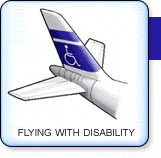|
|
Flying With Disability
| Post 9/11 |
|
Following the events of 9/11 travel has become more complicated for everyone. Disabled travellers, likewise, have been effected by the increased levels of security at airports around the world.
Flying with a disability, however, should not effect your travel plans in any way, though checks are now more stringent to guarantee the safety of passengers.
The Air Carrier Access Act (ACAA) and the Department of Transportation have since implemented rule to protect disabled travellers from discriminatory treatment on the basis of their disability.
The below information outline those rules and regulations within the US which has been implemented to ensure disabled travellers' rights are protected.
The Federal Aviation Administration note that the examples listed below are not all-inclusive, and are only designed to act as a response to many disabled travellers concerns arising following 9/11.
Check-in
* Air carriers must provide meet and assist service (e.g., assistance to gate or aircraft) at drop-off points. The lack of curbside check-in, for certain airlines at some airports, has not changed the requirement for meet and assist service at drop-off points.
Screener checkpoints
* Individuals assisting passengers with disabilities are allowed beyond the screener checkpoints. These individuals may be required to present themselves at the airlines' check-in desk and receive a "pass" allowing them to go through the screener checkpoint without a ticket.
* Ticketed passengers with their own oxygen for use on the ground are allowed beyond the screener checkpoints with their oxygen canisters once the canisters have been thoroughly inspected. If there is a request for oxygen at the gate for a qualified passenger with a disability, commercial oxygen providers are allowed beyond the screener checkpoints with oxygen canisters once the canisters have been thoroughly inspected. Commercial oxygen providers may be required to present themselves at the airlines' check-in desk and receive a "pass" allowing them to go through the screener checkpoint without a ticket.
* The limit of one carry-on bag and one personal bag (e.g., purse or briefcase) for each traveller does not apply to medical supplies and/or assistive devices. Passengers with disabilities generally may carry medical equipment, medications, and assistive devices on board the aircraft.
* All persons allowed beyond the screener checkpoints may be searched. This will usually be done through the use of a hand-held metal detector, whenever possible. Passengers may also be patted down during security screenings, and this is even more likely if the passenger uses a wheelchair and is unable to stand up. Private screenings remain an option for persons in wheelchairs.
* Service animals, once inspected to ensure prohibited items are not concealed, are permitted on board an aircraft. Any backpack or sidepack that is carried on the animal will be manually inspected or put through the X-ray machines. The service animal's halter may also be removed for inspection.
* Assistive devices such as walking canes, once inspected to ensure prohibited items are not concealed, are permitted on board an aircraft. Assistive devices such as augmentative communication devices and Braille 'N Speaks will go through the same sort of security screening process as used for personal computers.
* Syringes are permitted on board an aircraft once it is determined that the person has a documented medical need for the syringe.
* Personal wheelchairs and battery-powered scooters may still be used to reach departure gates after they are inspected to ensure that they do not present a security risk. Any backpack or sidepack that is carried on the wheelchair will be manually inspected or put through the X-ray machines.
* Personal wheelchairs will still be allowed to be stowed on board an aircraft.
* Air carriers must ensure that qualified individuals with a disability, including those with vision or hearing impairments, have timely access to information, such as new security measures, the carriers provide to other passengers. For example, on flights to Reagan Washington National Airport, persons are verbally warned to use the restrooms more than a half an hour before arrival since after that point in time passengers are required to remain in their seats. Alternative formats are necessary to ensure that all passengers, especially deaf persons, understand new security measures such as the one at Reagan Washington National.
|
|
|
